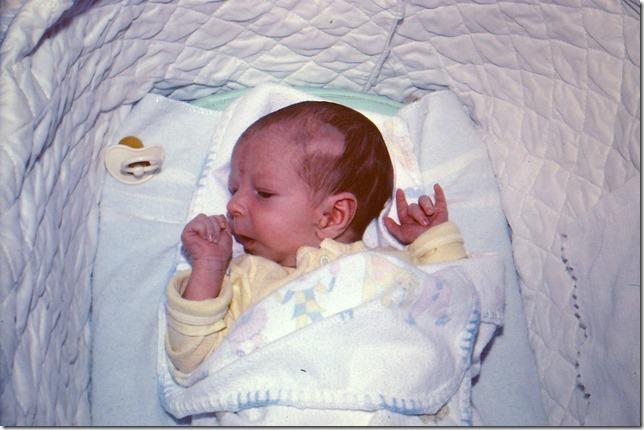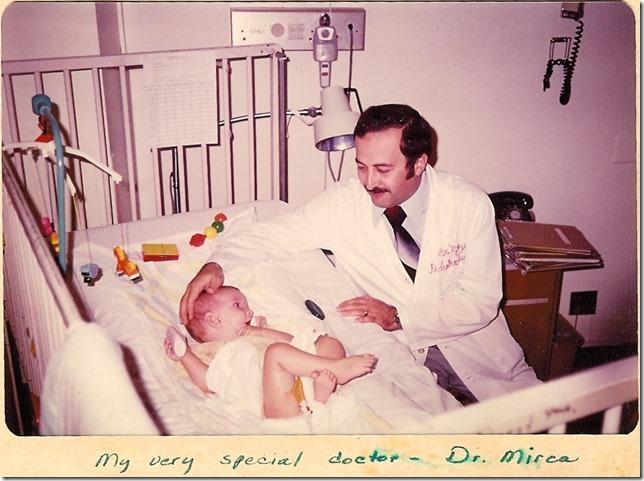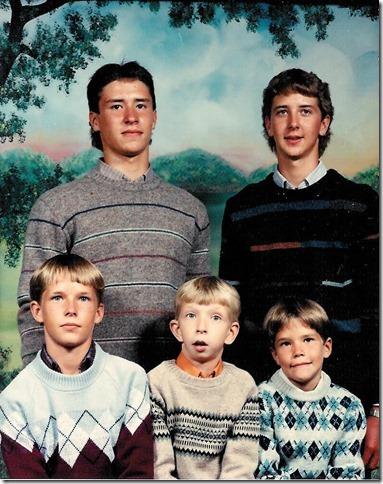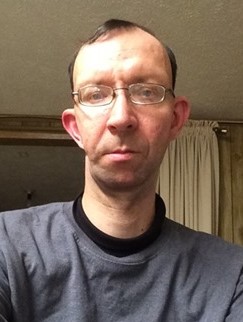
People like me are either targeted or don’t survive, but a little girl with a genetic abnormality saved my life.
I was born on November 4, 1977, in Moundridge, Kansas. I am the fourth in line of five boys born and raised by my parents. While my mom’s pregnancy with me was no different than her pregnancies with my three older brothers – uneventful, my birth revealed that I had a birth defect. The most serious concern was an incomplete anorectal opening. The doctor transferred me to a hospital in Wichita, Kansas.
Upon arrival, I underwent examination and blood work to find answers for the cause of my birth anomalies. The initial blood work diagnosis was that I had Downs Syndrome (Trisomy 21), but the pediatric surgeon questioned that result because he did see not the features of Downs Syndrome in me. He ordered more extensive blood testing to determine a proper diagnosis. The results came back as Trisomy 22, a rare chromosomal syndrome. The pediatric surgeon told my parents that I was the only survivor out of six documented cases in the U.S. There was no literature on Trisomy 22 that the hospital knew of which could guide my parents on what to expect going forward in raising a child with this condition. In fact, my dad went to public libraries to find information on Trisomy 22 and could not find anything.
I underwent 5 major surgeries before my first birthday. However, an anorectal pain issue related to my corrective surgery occurred five months later which left the pediatric surgeon puzzled. If he had no idea how to remedy it; my mom felt no other doctor could. Everybody, for that matter, was in the same predicament – my parents and doctors alike – in not knowing anything about this rare chromosomal syndrome and how to manage or treat some of the more mysterious issues which arose from it. They tried a natural health product which the pediatric surgeon had heard about and it resolved the pain issue.
At 13, though, a malabsorption issue associated with my Trisomy 22 appeared out of nowhere which became more mysterious than the pain at 15 months of age, and eventually became a life and death matter for me at age 41. This malabsorption started with table sugar and went on to impact other foods as the years went by. A large elbow macaroni was the only thing I could absorb at 41. Because this stemmed from the Trisomy 22, my parents and I did not have much confidence that doctors would be able to help me overcome this new struggle. All I could do was self-manage this condition by eliminating foods which caused very unpleasant intestinal issues.
In 2011, at the age of 33, my oldest brother encouraged me to retrieve my baby records, which included my genetic diagnosis, as a starting pointing to seek medical help in trying to resolve my malabsorption issues. Since my parents did not have my medical records, I sought them from the medical facilities I was at as a baby, but the statute of limitations had passed. With the information my mom had told me, I took to the Internet. I found a research publication which my pediatric geneticist had written in 2000 which changed everything for me. I fit the criteria of it and found a Trisomy 22 male baby listed in the publication. Although not identified by name, I sensed that Trisomy 22 male baby was in fact me.
While I saw several doctors throughout this 8-year journey, my health stumped them all, which did not surprise me. To counter the deterioration of my malabsorption condition and motivated by my pediatric geneticist’s publication, I made it a mission to undergo genetic testing to try to better understand why my Trisomy 22 was causing these malabsorption issues. I collaborated with my hometown general practitioner who happened to attend a genetics class taught by my pediatric geneticist, and he ordered four genetic tests for me which opened up avenues for me to research the relationship between my Trisomy 22 and my malabsorption issues.
The second of these tests in 2012 revealed that I had Mosaic (partial) Tetrasomy (four copies) 22 or Cat Eye Syndrome (CES), an adjusted diagnosis from my birth. However, the two extra copies which broke off of the original chromosome 22 copies attached themselves together to form the 47th chromosome – Trisomy 22. The third genetic test done in April 2018 was an intestinal tissue genetic biopsy which revealed that I had only 25% good absorptive cells left in my small intestine, the place where the bulk of absorption occurs. With each intestinal lining cell division, my mosaic Trisomy 22/CES cells became more plentiful, while my good cells became more scarce, explaining why my malabsorption was worsening. When my doctor looked at the results, he succinctly stated, “No wonder you have such little absorption capability left.”
In August 2019, my hemoglobin went from 9.1 to 4.9 (critically low) in only 12 days, making me too weak to walk. My doctor transferred me to a nearby hospital. I received 12 blood transfusions just to stay alive. An EMT, a high school classmate, told me that my body was using up all of the blood to keep my core and brain alive and could not make new blood cells fast enough to sustain my hemoglobin due to the lack of my ability to absorb food because of my Trisomy 22/CES. As a result, hematologists were brought in who looked over all my medical and genetic records, along with current research and transferred me to a more advanced hospital in Kansas City.
In Kansas City, I met two doctors, a hematologist and a gastroenterologist PA who each has a child with a chromosomal birth syndrome. When the GI specialist came into the room to see me, the words he spoke to me changed everything. He passionately stated, “I don’t have to be here, but I am here today because of my daughter who has an X-chromosome syndrome, and I want you to get better!” He added that my Trisomy 22/CES was responsible for my intestinal and health deterioration, but that I needed to expand my diet to improve my health to stay alive, meaning that I would have to eat foods which I could not absorb.
Knowing full-well what he was asking me to do, I had a choice to make – trust him or waste away and die. Because he values and loves his daughter, he was able to connect with me on a personal level through genetics, which made all the difference in the world for me to trust him and expand my diet. On Wednesday evening, August 28, 2019, I ate two grilled cheese sandwiches, a food which my GI tract would normally reject from an absorption standpoint. This time, though, I did not suffer the abdominal pain, the intense anorectal pressure, or diarrhea I normally did from foods like grilled cheese. As a result, it gave me confidence to try other foods in the coming days which normally would not absorb. As I ate these other foods over the next several days, I experienced no unpleasant intestinal issues. My hemoglobin stabilized and started to slowly rise each day.
I was sent back to the hospital near my hometown for inpatient physical therapy, being there only five days. On September 11, 2019, I was sent home, walking under my own power and with a hemoglobin of 10.4. My last hemoglobin check (10 months later) was 14.2, the highest it has ever been in my life.
God performed a miracle in my life on August 28, 2019 through this doctor’s daughter. She saved my life. Because of her genetic condition, many within this doctor’s own profession would have seen no value or worth to her life once born, questioning if she would make a positive contribution to society, therefore, labeling her a burden to society. Due to their medical opinion of who they deem “worthy”, they would promote and insist abortion for this child as the only “sensible” and “compassionate” thing to do for everyone’s sake involved. God, her parents, and I see it completely the opposite way, seeing value in her life and purpose for her life, as this miracle which occurred in my life is living proof of that! Had she not been allowed to be born, I would not be the writer of this article.
The consequences of and from abortion are endless. It has so many trickle-down effects that its impact goes well beyond just the two people it physically assaults – the mother and the unborn baby. One of the consequences of abortion is – when prenatal testing results detect the slightest suspicion of disability or abnormality and that baby is aborted, you lose such valuable live-born research which can be gathered and studied throughout an entire lifetime and applied in saving that person’s life and future peoples’ lives with the same or similar disability or abnormality as that initial person’s life. The more information available to treat a condition, even if rare, the better medical care doctors can provide to patients, saving their lives and improving their quality of life.
Medical technology and medical advancements are allowing doctors to now perform in-utero surgeries to correct and improve an unborn baby’s disability or abnormality to give that baby a better chance to not only live but thrive. That is amazing and awesome and absolutely runs counter to abortion. Combine those technologies and those advancements with embracing God’s creation of life and live-born research – genetic or otherwise, and I believe there are endless possibilities to save and improve lives. Is that not what medicine is all about – trying to save and preserve life from conception to natural death instead of devaluing and taking it through abortion and now assisted suicide and infanticide? I see a direct correlation of this devaluation of life to the Supreme Court ruling of January 22, 1973, which legalized abortion.
While it is true that life offers no guarantees, it is also true that abortion offers no chances at life. For those mothers and fathers considering abortion for their unborn baby, regardless of your or your baby’s circumstances or how your baby was conceived, think about the endless possibilities of how your unborn baby might one day impact the world and save someone else’s life by you choosing life for your unborn baby, just as this doctor’s daughter’s birth and life saved mine. The more we choose and advocate for life instead of abortion, the more patients, parents, families, and doctors can create a wider network of knowledge and support to help each other out in saving and improving all life. That is where I believe medicine can truly shine and become positive – by embracing life which God created instead of embracing coerced premature death.
Bio: Deon Durst from Moundridge, Kansas is a football coach, having coached at the junior high, high school, and college (NAIA – Tabor College) levels, and is now a pro-life blogger for Save The 1. Deon has 4 brothers, 4 nephews and 7 nieces.




